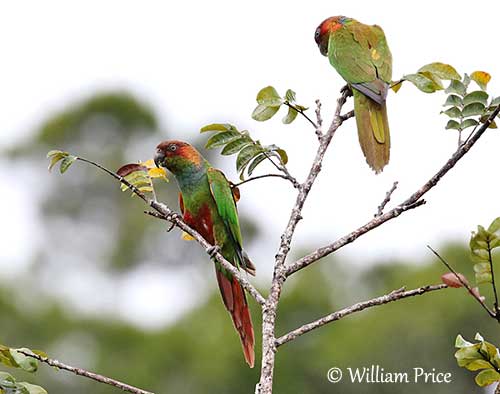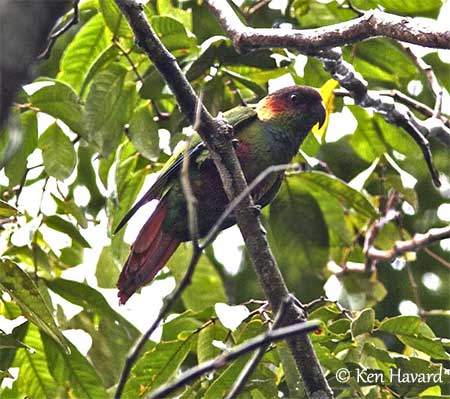
PROTECTION / THREATS / STATUS:
The Ochre-marked Parakeet is threatened by intensive forest clearance involving habitat fragmentation. Isolated populations are now confined to some reserves. Trapping for cagebird trade is relatively uncommon.
The population is roughly estimated to number 2,500/9,999 mature individuals, equating to 3,500/15,000 individuals. This population is suspected to be declining due to habitat loss.
The Ochre-marked Parakeet is currently classified as Vulnerable.
Fr: Conure tiriba
Ang: Ochre-marked Parakeet - Blue-throated Parakeet
All: Blaulatzsittich
Esp: Cotorra Tiriba - Perico Grande
Ita: Parrocchetto golablu
Nd: Blauwkeelparkiet
Sd: blåbröstad parakit
Portugais (Brésil): Tiriba-grande
Photographers:
Ken Havard
My Bird Gallery & Flickr gallery 1 & Flickr gallery 2
William Price
PBase-tereksandpiper & Flickr William Price
Text by Nicole Bouglouan
Sources:
HANDBOOK OF THE BIRDS OF THE WORLD vol 4 by Josep del Hoyo-Andrew Elliott-Jordi Sargatal - Lynx Edicions - ISBN: 8487334229
PARROTS OF THE WORLD – An Identification Guide – by Joseph M. Forshaw – Princeton University Press – ISBN 0691092516
Neotropical Birds – Cornell Lab of Ornithology
Wikipedia, the free encyclopaedia
THE AVIANWEB - Beauty of Birds (Sibylle Faye)
Ochre-marked Parakeet
Pyrrhura cruentata
Psittaciformes Order – Psittacidae Family
INTRODUCTION:
The Ochre-marked Parakeet is native to Brazil. It occurs in very fragmented habitat caused by intensive forest clearance. Illegal pet-trade is relatively new for this species which is rare as cagebird.
This species is mainly found in humid primary forest and margins where it usually occurs in flocks. It typically feeds on fruits and seeds from several native plant species.
The Ochre-marked Parakeet is currently classified as Vulnerable.
DESCRIPTION OF THE BIRD:
Biometrics:
Length: 30 cm
The Ochre-marked Parakeet shows distinctive head pattern with blackish crown and nape with pale flecks. Forehead, lores, eye’s area to ear-coverts are brownish-red, whereas neck sides are yellowish orange. The lower cheeks are green.
The body is manly green, but breast and thin nape collar are blue. Belly, rump and bend of the wing are red. On the wings, the primary flight-feathers are blue. The graduated tail is olive green above and mostly brownish red below.
The bill is grey. The eyes are yellow, surrounded by bare, grey eyering. Legs and feet are grey.
Male and female are similar.
The juvenile is duller, with brown eyes.

RANGE:
The Ochre-marked Parakeet is now mostly restricted to isolated reserves. This species is found in E Brazil, from SE Bahia to Rio de Janeiro. It occurs in Sooretama Biological Reserve and adjacent Linhares Forest Reserve, Espírito Santo. It is still common in Estaçao Vera Cruz, formerly the Porto Seguro Reserve, Bahia.
HABITAT:
The Ochre-marked Parakeet is mainly found in humid primary forest and margins, in small clearings and primarily in the forest canopy. It can be found in agricultural areas with sufficient tree cover such as shade cocoa plantations.
The species is visible up to 400 metres of elevation, and occasionally up to 960 metres.
CALLS AND SONGS: SOUNDS BY XENO-CANTO
The Ochre-marked Parakeet in flight or perched, gives series of short, nasal, harsh notes “kara kek kek kek…” and more piercing “krree” and “krek” calls are also heard. When in flight, some individuals of a group give high-pitched, chattering calls.
BEHAVIOUR IN THE WILD:
The Ochre-marked Parakeet feeds primarily on fruits and seeds from several plants species, especially Cecropia and Trema micrantha, two rainforest tree species.
It feeds in the canopy or in lower vegetation at forest edges, but it does not forage outside forest.

This gregarious species is usually seen in flocks of up to 20 birds. They are noisy while flying through the forest or above the canopy. They feed and roost in groups outside breeding season.
The Ochre-marked Parakeet typically nests in tree holes.
It is resident, with some movements between the forest fragments.
The flight is fast with shallow wingbeats.
REPRODUCTION OF THIS SPECIES:
The breeding season takes place in the austral spring.
The Ochre-marked Parakeet nests in hole in tree, sometimes up to ten metres above the ground.
In captivity, the female lays 2-4 white eggs. Both adults incubate during 22-25 days. The young fledge 45 days after hatching.
